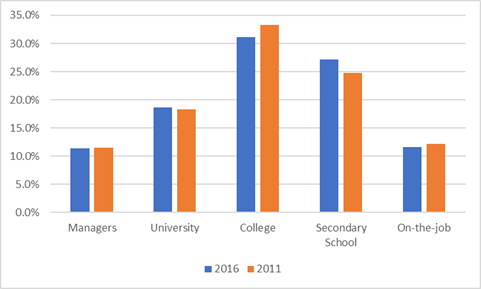It’s Davos time, when we get to find out what the world’s power elite would like everyone else to freak out about for the next twelve months. What is happening this year? The theme is “stakeholders for a cohesive and sustainable world”, and while my impression is that the emphasis will be on the latter (Greta Thunberg has already had a powerful headliner), I think cohesion will still get some attention. And where cohesion is concerned, they’re going to be talking about one thing: The Fourth Industrial Revolution.
The reason they’ll be using that phrase is that it was coined by Klaus Schwab, the guy who runs Davos. It’s conceptually a bit murky, but as he puts in in his book The Fourth Industrial Revolution, what it basically what it comes down to is:
- There is a “staggering confluence of emerging technology breakthroughs, covering wide-ranging fields such as artificial intelligence (AI), robotics, the internet of things (IoT), autonomous vehicles, 3D printing, nanotechnology, biotechnology, materials science, energy storage and quantum computing, to name a few.”
- “Many of these innovations are in their infancy, but they are already reaching an inflection point in their development as they build on and amplify each other in a fusion of technologies across the physical, digital and biological worlds”.
This second point leads Schwab to suggest that the Fourth Revolution is different from the Third because “contrary to the previous industrial revolutions, this one is evolving at an exponential rather than linear pace”. This leads to all sorts of talk about disruption, job-killing robots, mass unemployment, and that tech-bro favourite, universal basic income to keep the plebs fed and clothed once the job-killing robots have done their thing. (In fairness, Schwab is not quite as much of a swivel-eyed loon about this as some of the hacks who have glommed on to this intellectual shtick)
This all sounds fine and dandy and there is only one real problem with this argument. Namely, that it is bollocks, in ways that become obvious to anyone with the inclination to look at data rather than repeat trite nonsense.
Let’s start with the job-killing robot issue. If the economy were under relentless assault from automation, it would show up first in the unemployment statistics. So below in Figure 1, I plot a 6-month rolling average of the number of new unemployment claims as a percentage of the actual labour market. It shows that new unemployment claims are relentlessly decreasing as a fraction of the overall labour market.
Figure 1: New Unemployment Claims as a Percentage of the Labour Market, Canada, 2000-2019

recent review of data on labour productivity. From 1990 to 2000, labour productivity growth averaged 3.55 percent per year. Since 2000, average labour productivity growth has been 0.34% – that is, productivity has fallen by 90% since the 90s.
Neither of these pieces of data is remotely consistent with a story of ever-accelerating economic disruption. If there were job-killing robots, we would expect to see increasing job losses, and faster labour productivity growth. These pieces of data suggest that far from being in an era of unprecedented change, we are in an era of unprecedented stagnation.
Think we’re in an era of risk-taking and entrepreneurialism? Wrong: new firm formation is at a historic low. Think AI is going to wipe out all the jobs? Maybe read some the latest thinking on how the main approaches to AI are basically a dead-end (remember all those stories four years ago about AI replacing radiologists, like, yesterday? Well, to date there appear to be no recorded cases of radiologists losing their jobs due to technology).
Or: think jobs are becoming rapidly de-skilled? Statscan codes every occupation’s skill level – that is, the minimum education required to fill jobs in each occupation. Figure 2 shows the change between 2011 and 2016 – and at most, what you can say is that the number of jobs requiring college has dropped a bit (though this seems to be as much to do with the end of the commodities boom as it does any secular changes in the labour market).
Figure 2: Number of Employed Individuals by Occupational Skill Level, Canada, 2011 vs. 2016

I know there is a whole industry of “thought leaders” in Ottawa and elsewhere who really want to push this notion that radical change is occurring and its going to change everything and omg panic. But it’s just not true. There isn’t a single indicator out there suggesting the “increasing pace of change” story is true. Which in turn means the whole “Fourth Industrial Revolution” rhetoric is nonsense, at least if you are using it as a concept to describe the present day.
Of course, none of this will stop some ridiculous op-eds from being penned on this subject over the next week or two, because Davos people gonna spread Davos ideas, no matter what (odds are strong at least one of them will come from McGill Principal Suzanne Fortier, who really seems to dig this concept). It’s just that, given the actual data, you should feel free to ignore them.

 Tweet this post
Tweet this post

Well said Alex – I liked this so much that I borrowed it. https://www.productivity.govt.nz/futureworknzblog/debunking-fallacies-couldnt-say-it-better-myself/